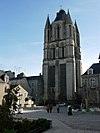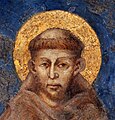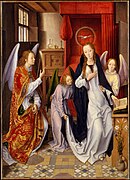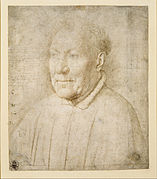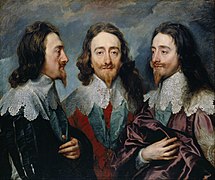|
THE SAINTS PORTAL
Showcased saint-related content In Christian belief, a saint is a person who is recognized as having an exceptional degree of holiness, likeness, or closeness to God. However, the use of the term saint depends on the context and denomination. In Catholic, Eastern Orthodox, Anglican, Oriental Orthodox, and Lutheran doctrine, all of their faithful deceased in Heaven are considered to be saints, but some are considered worthy of greater honor or emulation. Official ecclesiastical recognition, and consequently a public cult of veneration, is conferred on some denominational saints through the process of canonization in the Catholic Church or glorification in the Eastern Orthodox Church after their approval. While the English word saint originated in Christianity, historians of religion tend to use the appellation "in a more general way to refer to the state of special holiness that many religions attribute to certain people", referring to the Jewish ḥasīd or tzadik, the Islamic walī, the Hindu rishi or Sikh Bhagat and guru, the Shintoist kami, the Taoist shengren, and the Buddhist arhat or bodhisattva also as saints. Depending on the religion, saints are recognized either by official ecclesiastical declaration, as in the Catholic faith, or by popular acclamation (see folk saint). (Full article...) Selected biography
Saint Jovan Vladimir or John Vladimir (Serbian Cyrillic: Јован Владимир; died 22 May 1016) was ruler of Duklja, the most powerful Serbian principality of the time, from around 1000 to 1016. Duklja was conquered in around 1010 by the expansionist Tsar Samuel of Bulgaria, who took Jovan Vladimir prisoner. A medieval chronicle asserts that Samuel's daughter, Theodora Kosara, fell in love with Vladimir and begged her father for his hand. The tsar allowed the marriage and returned Duklja to Vladimir, who ruled as his vassal. He was acknowledged as a pious, just, and peaceful ruler. In 1016 Vladimir was beheaded in Prespa by order of Samuel's successor, Ivan Vladislav, and was buried there. He was soon recognized as a martyr and saint; his feast day is celebrated on 22 May. Kosara reburied him in Duklja, and in 1381 his relics were preserved in the Church of Saint Jovan Vladimir near Elbasan. Since 1995 the relics have been kept in the Orthodox cathedral of Tirana, Albania; on his feast day they are taken back to the church near Elbasan for a celebration. The cross Vladimir held when he was beheaded is traditionally under the care of the Andrović family from southeastern Montenegro. The cross is carried on the Feast of Pentecost in a procession to the summit of Mount Rumija. Jovan Vladimir is regarded as the first Serbian saint. He is fabled to have carried his severed head to his place of burial.
Did you know...
Selected saint days
General imagesThe following are images from various saint-related articles on Wikipedia.
CategoriesRelated portalsWikiProjects The Saints Wikiproject aims primarily at standardizing the articles about people venerated by some Christians as saints or the blessed and ensuring quality articles. If there is an interest in including saints from religions other than Christianity, please propose those changes on our talk page. Related topicsSaints: Saint Michael - Saint Gabriel - Virgin Mary - Saint Joseph - Saint John the Baptist - Saint Stephen - Saint Peter - Saint Paul - Saint Augustine of Hippo  Traditions: Calendar of saints - Hagiography - List of saints - Symbology of the Saints Theology: Communion of Saints - Intercession of saints - Martyrs - Patron saint Roman Catholicism: Congregation for the Causes of Saints - Servant of God - Venerable - Beatification - Canonization Muslim Sufi saints: 'Abd al-Qadir al-Jilani - Ahmad al-Rifa'i - Ibrahim al-Disuqi - Ahmad al-Badawi - Al-Shadhili - Baha' al-Din Naqshband - Ibn 'Arabi - Wali Sanga Recognized content
Featured articlesGood articles
Featured pictures
Former featured pictures
Things to doAssociated WikimediaThe following Wikimedia Foundation sister projects provide more on this subject:
Discover Wikipedia using portals |

